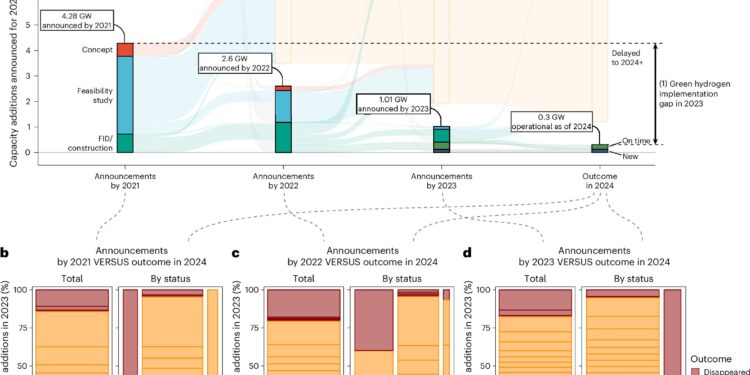The green hydrogen implementation gap by 2023. Credit: Natural energy (2025). DOI: 10.1038/s41560-024-01684-7
In recent years, more than 60 countries have developed strategies to stimulate the rise of the hydrogen market, particularly in the industrial sector. However, in 2023, less than 10% of the green hydrogen production initially announced has been achieved, shows a new study published in the journal Natural energy.
The main reason: hydrogen remains an expensive good for which there is little willingness to pay. Adrian Odenweller and Falko Ueckerdt from the Potsdam Institute for Climate Impact Research (PIK) determined this competitiveness gap for all 1,232 hydrogen projects announced worldwide. They argue for a strong policy strategy, based on realistic hydrogen expectations and closing implementation gaps.
“Over the past three years, announcements of global green hydrogen projects have almost tripled,” says Odenweller, PIK researcher and lead author. “However, only 7% of the production capacity initially announced for 2023 was completed on time during this period.”
According to the study, recent problems with the ramp-up of the green hydrogen market can be attributed to rising costs, lack of willingness to pay on the demand side, and uncertainties over future subsidies and regulations.
“Huge additional subsidies, of around a trillion US dollars, would be needed to realize all the announced hydrogen projects by 2030,” says PIK’s Ueckerdt. “Green hydrogen will still struggle to meet high expectations in the future due to a lack of competitiveness. “
However, permanent subsidies are not a solution. The two researchers therefore recommend using demand-side instruments such as binding quotas to channel green hydrogen specifically towards sectors that are difficult to electrify, such as aviation, steel or chemicals. For example, according to a European regulation, 1.2% of all aviation fuels must be blended with synthetic hydrogen fuels from 2030. This quota is expected to increase to 35% by 2050.
Grant requirements far exceed announced global grants
In their study, the researchers quantified three key gaps between theory and practice: the past implementation gap, the future ambition gap, and the future implementation gap. The first results come from the difference between the hydrogen projects initially announced and the projects actually carried out in 2023. The ambition gap refers to the gap between the quantity of hydrogen that would be needed by 2030 according to the scenarios of 1.5 degrees and projects currently announced by 2030.
Although the hydrogen projects announced are sufficient for the majority of the scenarios analyzed, a significant implementation gap remains: the subsidies necessary to realize all projects by 2030 far exceed the global public financial support announced until here.
The study is based on a global, hand-verified project database with 1,232 green hydrogen projects announced through 2030. For each of the projects’ 14 designated end uses, the authors calculate the competitiveness gap between the green product and its fossil competitor. With the volume and timing of project announcements, this provides the grants needed to complete all projects by 2030.
Researchers warn against blocking fossil fuels, which could tie companies to fossil fuels and thus endanger climate goals. In the long term, a transition to technology-neutral market mechanisms, such as carbon pricing, is crucial to limit public costs and ensure a level playing field with other climate change mitigation options. . They therefore recommend a robust strategy that supports hydrogen projects in the short term through direct subsidies and demand-driven regulation, but is based on realistic hydrogen expectations.
More information:
Odenweller, A. et al. Green hydrogen ambition and implementation gap, Natural energy (2025). DOI: 10.1038/s41560-024-01684-7, www.nature.com/articles/s41560-024-01684-7
Provided by the Potsdam Institute for Climate Impact Research
Quote: Green hydrogen: study shows big gaps between ambition and global implementation (January 14, 2025) retrieved January 14, 2025 from
This document is subject to copyright. Except for fair use for private study or research purposes, no part may be reproduced without written permission. The content is provided for informational purposes only.



